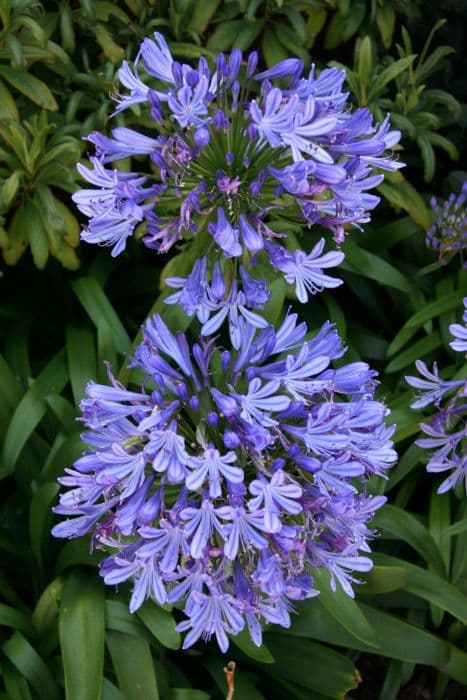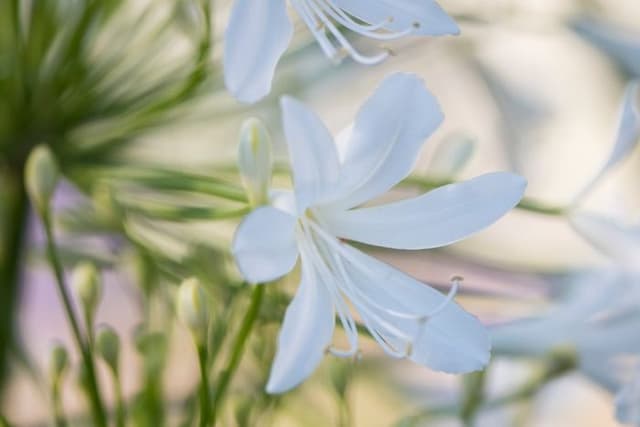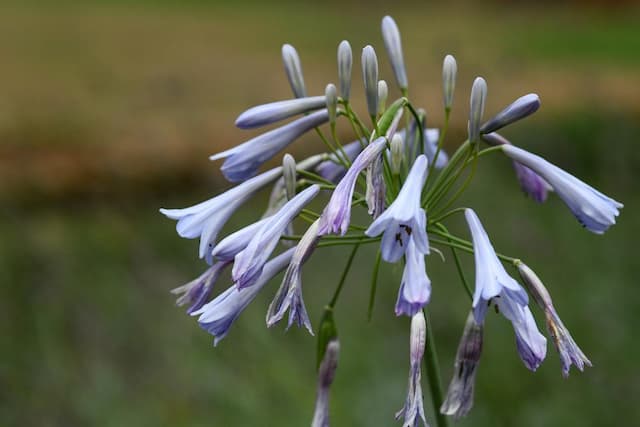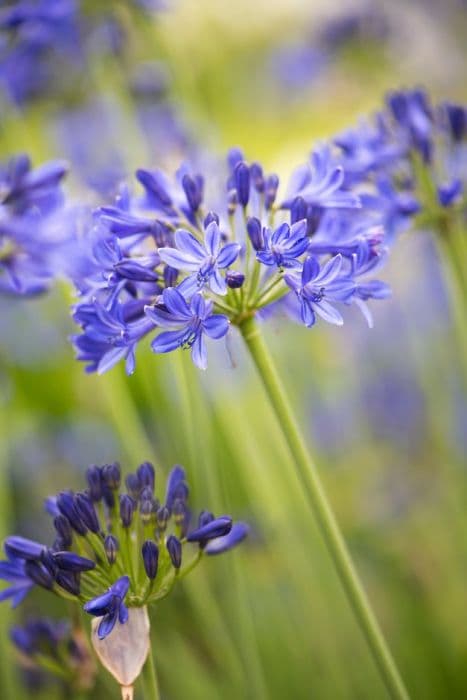Lily of the Nile Agapanthus 'Lilac Time'

ABOUT
Agapanthus 'Lilac Time' is a striking ornamental plant that is often admired for its lush, strap-shaped leaves which create a dense foliage clump at the base. This plant is celebrated for its impressive bloom display; atop sturdy, erect stalks it bears umbels of trumpet-shaped flowers. The blossoms display a delicate lilac color, lending to the plant's name 'Lilac Time'. Each flower cluster can contain numerous individual florets that contribute to a full and rounded inflorescence, creating a soft, yet eye-catching visual impact. The blossoms are known to attract a variety of pollinators, adding a dynamic element to its presence in the garden. The overall look of Agapanthus 'Lilac Time' is one of elegance and vibrancy, making it a popular choice for gardeners wanting to add a touch of color and sophistication to their outdoor spaces.
About this plant
 Names
NamesFamily
Amaryllidaceae
Synonyms
African Lily, Lily of the Nile, Love Flower
Common names
Agapanthus 'Lilac Time'.
 Toxicity
ToxicityTo humans
The Agapanthus, commonly known as the Lily of the Nile, is not considered highly toxic to humans, but it does contain certain compounds that can potentially cause skin irritation or, if ingested, may lead to mild stomach upset. Ingesting parts of the plant, such as leaves or flowers, may result in symptoms that could include nausea, vomiting, and diarrhea. These symptoms tend to be minor, and severe poisoning is rare. However, it is advised to handle the plant with care and to avoid ingesting any part of it to prevent any possible adverse reactions.
To pets
The Agapanthus, or Lily of the Nile, is known to be toxic to pets, particularly cats and dogs. If a pet ingests any part of the plant, it can result in vomiting, diarrhea, nausea, and in some cases, excessive salivation. The plant contains substances that can potentially cause gastrointestinal upset and other mild to moderate symptoms of toxicity. It is important to keep this plant out of reach of pets and to contact a veterinarian if you suspect your pet has ingested any part of it. Symptoms of poisoning can vary in severity, so prompt veterinary attention is advisable to ensure the health and safety of the animal.
 Characteristics
CharacteristicsLife cycle
Perennials
Foliage type
Evergreen
Color of leaves
Green
Flower color
Lilac
Height
2 feet (60 cm)
Spread
2 feet (60 cm)
Plant type
Bulb
Hardiness zones
8
Native area
South Africa
Benefits
 General Benefits
General Benefits- Attractive Flowers: Agapanthus 'Lilac Time' produces beautiful lilac-colored blooms that add a pop of color to gardens and landscapes.
- Drought Tolerance: Once established, it is relatively drought-tolerant, requiring minimal watering and maintenance.
- Long Blooming Period: This plant has a lengthy blooming season, providing extended visual interest throughout the summer months.
- Wildlife Attraction: The flowers can attract pollinators like bees and butterflies, contributing to the health of the local ecosystem.
- Architectural Structure: The tall flower stalks and strap-shaped leaves provide vertical interest and a striking architectural presence in garden design.
- Container Gardening: Suitable for pots and containers, it is ideal for people with limited garden space.
- Borders and Edging: Can be used as an effective border or edging plant, creating defined lines and areas within the garden.
 Medical Properties
Medical PropertiesThis plant is not used for medical purposes.
 Air-purifying Qualities
Air-purifying QualitiesThis plant is not specifically known for air purifying qualities.
 Other Uses
Other Uses- As a cut flower in arrangements: Agapanthus 'Lilac Time' has long, sturdy stems, making it an excellent choice for inclusion in floral arrangements where their vibrant blossoms add a splash of color.
- As a natural dye: The flowers can be used to extract a lilac to blue dye for fabrics and art projects.
- In eco-friendly confetti: The petals of Agapanthus 'Lilac Time' can be dried and used as a biodegradable confetti alternative at weddings and celebrations.
- As a border plant to deter animals: Planting Agapanthus 'Lilac Time' around the perimeter of a garden can deter certain animals because they do not like the taste or texture of its leaves.
- As a means to prevent soil erosion: Their robust root system can help in stabilizing slopes and prevent soil from eroding.
- As an educational tool: Agapanthus 'Lilac Time' can be used in educational settings to teach students about plant biology, pollination, and botany.
- In photography and art: The striking form and color of Agapanthus 'Lilac Time' make it a popular subject for photographers and artists.
- As a structural element in landscape design: Its upright form and clumping habit can be used to add vertical interest and structure to garden beds.
- In ponds and water gardens: While not aquatic, Agapanthus 'Lilac Time' can be planted around the edges of water features to enhance the aesthetic appeal.
- For themed gardens: Suitable for "moon gardens", where its light colored blossoms can reflect moonlight and thus become a focal point during the evening hours.
Interesting Facts
 Feng Shui
Feng ShuiThe Lily of the Nile is not used in Feng Shui practice.
 Zodiac Sign Compitability
Zodiac Sign CompitabilityThe Lily of the Nile is not used in astrology practice.
 Plant Symbolism
Plant Symbolism- Love Letters: The name Agapanthus comes from the Greek words 'agape' meaning love and 'anthos' meaning flower. As such, it often symbolizes love letters or messages.
- Enduring Love: With its long-lasting blooms, the Agapanthus represents an enduring or long-lasting love.
- Beauty: The striking appearance of the 'Lilac Time' variant, with its beautiful lilac-colored flowers, is commonly associated with beauty and admiration.
- Fertility: The Agapanthus is known to be a prolific bloomer and is often associated with fertility or abundance.
- Strength: The sturdy stems of Agapanthus can symbolize strength and resilience, standing tall and withstanding various conditions.
 Water
WaterAfrican Lily requires regular watering to thrive, especially during the growing season from spring through fall. A good rule of thumb is to water once a week with about one to two gallons of water, depending on the size of the plant and the weather conditions. During the hotter, drier periods, you may need to water more frequently, ensuring the soil remains moist but not waterlogged. In the winter, when the plant is dormant, reduce watering to every few weeks, just enough to prevent the soil from completely drying out.
 Light
LightAfrican Lily flourishes best in full sun to partial shade conditions. The ideal spot for this plant is where it can receive at least six hours of direct sunlight each day, though it can tolerate some light afternoon shade. Avoid placing it in deep shade, as this can diminish blooming and weaken the plant.
 Temperature
TemperatureAfrican Lily thrives in temperature ranges between 50°F to 90°F. It can survive minimum temperatures down to about 20°F, but ideally should not be exposed to freezing conditions for prolonged periods. The optimum temperature for robust growth and flowering is between 60°F and 80°F.
 Pruning
PruningTo promote vigorous growth and blooming in African Lily, pruning is necessary. Deadhead spent flowers throughout the blooming season to encourage new blooms. After flowering has finished, usually in the fall, cut back the flower stalks to the base. Every few years, you may also want to divide overcrowded clumps in early spring, which also helps rejuvenate the plant.
 Cleaning
CleaningAs needed
 Soil
SoilThe Agapanthus, commonly known as Lily of the Nile, thrives in a soil mix that is well-draining, rich in organic matter, and has a slight acidity to neutrality with a pH between 6.0 to 7.0. A recommended soil mix might include two parts loam, one part perlite or coarse sand, and one part compost to ensure good drainage and fertility.
 Repotting
RepottingLily of the Nile generally prefers to be somewhat root-bound, so repotting every 2-3 years is usually sufficient. However, if you notice roots protruding from the pot's drainage holes or the plant's growth appears to be stunted, it's time to repot into a slightly larger container.
 Humidity & Misting
Humidity & MistingLily of the Nile, being fairly tolerant of different humidity levels, grows best in moderate humidity conditions. It does not require any specific humidity adjustments, making it a versatile plant for various indoor environments.
 Suitable locations
Suitable locationsIndoor
Provide bright light and avoid over-watering.
Outdoor
Plant in full sun to partial shade; water regularly.
Hardiness zone
8-11 USDA
 Life cycle
Life cycleThe life cycle of Agapanthus 'Lilac Time', commonly known as the Lily of the Nile, begins with seed germination, requiring a warm and moist environment. Once germinated, the seedling develops a root system and foliage, entering a juvenile vegetative stage. As it matures, the plant forms a clump with strap-shaped leaves, and when it has accumulated enough energy and has met the right conditions, it progresses to the flowering stage, typically in the summer, producing tall stalks with lilac umbels. After pollination, the flowers develop into seed capsules, and once dry, these release seeds, continuing the life cycle. During winter or less favorable seasons, the plant may enter a dormancy phase, particularly in cooler climates, where it conserves energy. Perennial in nature, Agapanthus 'Lilac Time' will repeat this cycle annually, with clumps increasing in size over the years, sometimes necessitating division to maintain vigor.
 Propogation
PropogationPropogation time
Early Spring
One of the most popular methods for propagating Agapanthus 'Lilac Time', commonly known as the Lily of the Nile, is through division of the plant's clumping root system. This is best done in the spring, just as new growth begins to appear, which provides the best conditions for the divisions to establish themselves. The process involves gently removing the plant from the ground and carefully separating the clump into smaller sections, making sure that each division has a portion of the root system. These divisions can then be immediately replanted in well-draining soil, spaced at intervals of about 12 to 18 inches (approximately 30 to 45 centimeters) to allow for growth. Within a few weeks, the divisions should start producing new shoots, eventually leading to a fully established plant that will blossom in its season.









